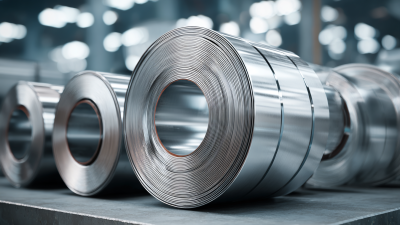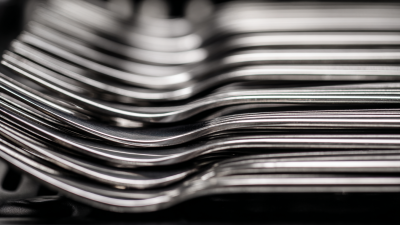In the world of materials, few can match the versatility and durability of stainless steel. However, navigating the various stainless steel grades can often be overwhelming for consumers and professionals alike. According to Dr. Emily Miller, a renowned metallurgist and expert in stainless steel applications, "Understanding the different stainless steel grades is crucial for selecting the right material for any project." This comprehensive guide aims to shed light on the intricacies of these grades, ensuring that you make informed decisions in your everyday use.

Each stainless steel grade possesses unique properties, affecting its strength, corrosion resistance, and suitability for specific applications. By dissecting the distinct categories of stainless steel, this guide will help demystify the selection process. In addition, it will provide practical insights into how these grades impact everyday items, from kitchen appliances to industrial machinery, ultimately enhancing your understanding and appreciation of this remarkable alloy.
As we delve deeper into the subject, you'll discover how the right stainless steel grade can not only improve the longevity of products but also contribute to safety and efficiency in various industries. Whether you're a DIY enthusiast or a seasoned professional, grasping the significance of stainless steel grades is essential for success in any project involving this indispensable material.
Stainless steel is a versatile material widely used in various applications due to its excellent resistance to corrosion and staining. Understanding the common types of stainless steel grades is essential for choosing the right one for your needs. The most recognized grades include 304 and 316, each possessing unique properties that cater to different environments.

Grade 304, also known as 18/8 stainless steel, contains 18% chromium and 8% nickel, making it ideal for kitchen appliances, utensils, and food processing. Its good formability and weldability further enhance its appeal in everyday products.
On the other hand, grade 316 offers superior corrosion resistance, especially in marine and chemical environments due to its addition of molybdenum. This makes it the preferred choice for applications exposed to saltwater or harsh chemicals, such as in surgical instruments, outdoor furniture, and industrial equipment. Understanding these variations in stainless steel grades enables consumers and manufacturers to select the right material for durability and performance, ensuring successful long-term use in everyday settings.
Stainless steel is a popular material for everyday applications, particularly 304 and 316 grades, which are renowned for their durability and resistance to corrosion. The 304 stainless steel, often described as the most versatile grade, comprises 18% chromium and 8% nickel. It is commonly used in kitchenware and appliances due to its excellent fabrication characteristics and resistance to oxidation. Recent reports highlight its application in various products, emphasizing that it maintains quality even under high temperatures, making it suitable for cooking and food storage.

On the other hand, 316 stainless steel offers enhanced corrosion resistance, particularly against chlorides and acidic environments, due to the addition of molybdenum. This makes it an ideal choice for marine environments and medical applications. A study projects that the global stainless steel market is expected to grow at a compound annual growth rate of 5.9% from 2023 to 2030, signifying an increasing demand driven by the need for durable and safe materials across different sectors. As consumers become more aware of material safety and durability, understanding the distinctions between these grades will help them make informed purchasing decisions.
When it comes to selecting stainless steel for everyday applications, understanding the differences in corrosion resistance among various grades is crucial. Stainless steel is classified into several grades, primarily based on its composition, which significantly influences its ability to withstand environmental challenges. For instance, the widely used 304 grade exhibits excellent resistance to corrosion due to its high nickel and chromium content, making it ideal for kitchen appliances and food processing equipment. However, in more demanding environments, such as marine applications, 316 grade stainless steel is preferred due to its added molybdenum, which enhances its resistance to chlorides and saltwater.
In contrast, lower-grade options like 430 stainless steel, while cheaper and suitable for specific uses like automotive trim, offer limited corrosion resistance and are better suited for dry environments. Understanding these nuances enables consumers and manufacturers to choose the right grade based on anticipated exposure conditions. Evaluating factors such as temperature, humidity, and the presence of corrosive agents helps ensure long-lasting performance and reduces maintenance costs over time.
When it comes to food safety and hygiene, choosing the right stainless steel grade is crucial. Stainless steel is widely used in kitchens and food processing because it resists corrosion and is easy to clean. The most common grades used in food applications are 304 and 316 stainless steel.
Grade 304 offers excellent resistance to oxidation and is typically used for equipment that comes into contact with food. It is non-reactive and can withstand a variety of acidic and alkaline foods, making it a reliable choice for cookware, countertops, and storage containers.
On the other hand, Grade 316 stainless steel provides an additional layer of protection due to the presence of molybdenum, enhancing its corrosion resistance, especially in saline environments. This makes it an ideal option for marine applications or areas with high humidity, where equipment is exposed to harsh conditions. When selecting stainless steel for food-related use, it is essential to consider the type of food being prepared and the environment in which the equipment will be used.
Ensuring compliance with sanitary standards is vital to protect both the quality of food and the health of consumers.
Stainless steel is renowned for its durability and versatility, owing much of its properties to the alloying elements used in its composition. Nickel, for instance, is a crucial element that enhances the corrosion resistance and strength of stainless steel, making it an indispensable material in various applications, including kitchenware, automotive parts, and construction. The variations in nickel content within different stainless steel grades dictate their usability in specific environments, as higher nickel concentrations typically provide better resistance to harsh conditions.
Moreover, the importance of recycling stainless steel cannot be understated in the context of sustainable development. As a green product, stainless steel can be recycled indefinitely without significantly losing its properties, promoting a circular economy. Recent studies illustrate that the recycling rate of stainless steel is impressively high, due to effective collection and processing technologies. This not only reduces waste but also lessens the demand for virgin materials, ultimately benefiting both the environment and the economy. Consequently, understanding the role of alloying elements like nickel and the recycling processes associated with stainless steel is essential for industries aiming to maximize efficiency and sustainability.
This chart illustrates the composition of different stainless steel grades and their common applications based on alloying elements.






To learn more about any of the products and services provided by Abbott Ball Company, Inc., simply complete the form below.